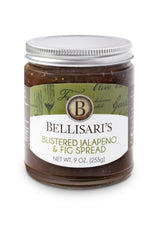Like scotch and caviar, it is often said that liking blue cheese is an “acquired taste,” but in my case, I think I’ve always liked it. At least I don’t remember a time when I didn’t. I loved the tang of blue cheese salad dressing or crumbled blue cheese in a salad which was my introduction to it. The funky smell wasn’t that evident in those forms, and by the time I saw a “moldy,” “smelly” piece of delicious blue cheese, I already knew I liked it, so I wasn’t put off. I love it enough that I created Bellisari’s Blue Cheese, Honey & Shallot Spread.
In my reading about blue cheese in preparation of writing today’s blog, I found a couple different legends about how blue cheese was discovered, but the most popular one says that sometime during the 7th century, outside the village of Roquefort in France, a shepherd, distracted by a beautiful maiden, forgot his lunch of bread and cheese in a cave. When he returned a few months later, the shepherd saw that a blue mold had formed on the outside of the bread. Since the bread and the cheese were touching, the mold had spread onto the cheese. My biggest question is: What made the shepherd think that it was a good idea to eat the moldy cheese?!? I’m glad he did, however, and even happier that he liked what he tasted.
For the longest time, the cheese from Roquefort was made by putting bread in the cave, letting the mold form, then scrunching up the bread and smearing it all over the outside of the cheese. We have long ago been able to generate the mold in a laboratory, and it is now identified as Penicillium Roqueforti. No bread is involved. The promotion of mold on the inside of the cheese is done by piercing the cheese with long needles to create air passages that allow mold to grow. That's why you see blue veins throughout the cheese. Don’t fear the mold! The mold used in blue cheese, unlike some molds which produce toxins—is safe to consume.
Often associated with one characteristic blue flavor, blue cheese comes in all types of textures and variations of flavor. The density of the cheese can range from creamy and buttery to crumbly, which showcases the blue mold in a flavor profile ranging from subtle and grassy to mineral and piquante.
Many blue cheeses are made from whole cow's milk, but they are also made with ewe's or goat's milk. These complex blue veined cheeses are generally ranked as some of the best cheeses in the world. They are strong flavored, and have a unique 'tang' that distinguishes them. Some of the best are Roquefort, Stilton, Gorgonzola, and Danablu.
Blue cheeses often have a salty bite. That's because salt is added to act as a preservative and keep any bad bacteria from growing. It's also why blue cheeses taste amazing with sweet wines or when drizzled with honey. It's a salty-sweet match made in heaven.
Today most blue cheeses are either injected with the mold, as with Roquefort, or the mold is mixed right in with the curds, as it is with Gorgonzola, to ensure even distribution of the mold. Most of these cheeses must still be aged in the original caves in France where they were developed to bear the name. Thankfully, other cheesemakers around the world have developed their own blue cheeses, so even if you think you don’t like blue cheese, I contend you just haven’t met your soulmate of blue cheese yet.
If you are looking for a good way to ease your family into knowing and liking blue cheese, this familiar dish with a blue-cheese twist might be a good start. Our Blue Cheese Mac & Cheese features familiar cheeses like cheddar and Gruyere along with our Blue Cheese, Honey, & Shallot spread, bringing the perfect sweet and savory flavors to balance the tangy, slightly salty blue cheese. If mac and cheese isn’t your thing, find many more recipes on the website that include Bellisari’s Blue Cheese, Honey, & Shallot Spread.







